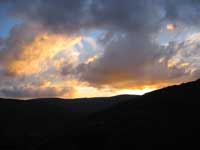
If this message gets posted it will mean that I finally
succeeded in connecting LeTravers to the rest of the world…
Clearly not via cable but using good old dial-in. I don't think
I'll ever see cable appearing here.
Electricity made it
appearance here only 10 years ago (and is an end-of-network setup
meaning that if two people on the mountain use a microwave, all lights
are dimmed…) and since 5 years one can reach us by telephone.
Since then I've been trying to get email working using
all sorts of (Belgian) dial-in adresses but nothing worked, the modem
didn't seem to be working. It turned out that in France you first
have to buy a special socket for the telephone outlet (costs 50FF)
which our neighbors promised to provide by the next time we came
along.
So, next time expectations were high and sure enough
I could hear the typical modem-noises until they got into an infinite
loop without ever making the connection.
Some people were
luckier but then they used a Windows-clone and even mimicking their
connection on a Mac didn't work. For some mysterious reason it
seemed that Macintosh computers (or at least their modems) were
incompatible with FranceTelecom.
Last week I did try
another option : I got a webpage with all free internet providers and
applied for a username-password with two of them (FreeFrance and
Tiscali). FreeFrance promised to send a package with the post whereas
Tiscali immediately replied with a dial-in nummer, username and
allowed me to set up my own password.
So, after driving
1000km (half of which in the pouring rain) and enjoying a glass of
rose outside in the setting sun (picture) I tried the Tiscali
connection without too much hope, but I think it works.
It
was a beautiful sunny afternoon (it seems it has been raining here
more or less continuously for the last three weeks) but at sunset the
clouds were rather threatening and sure enough the following day
(sunday) we spend the day within rain clouds.